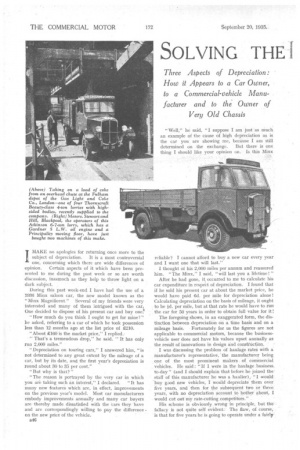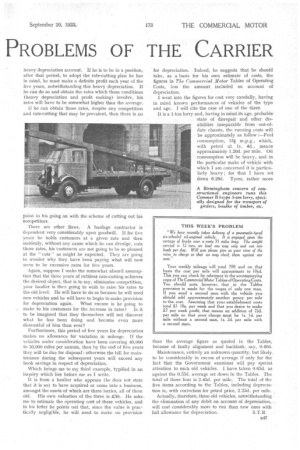SOLVING THE I PROBLEMS OF THE CARRIER
Page 64

Page 65

If you've noticed an error in this article please click here to report it so we can fix it.
IMAKE no apologies for returning once more to the subject of depreciation. It is a most controversial one, concerning which there are wide differences of opinion. Certain aspects of it which have been pre
sented to me during the past week or so are worth discussion, inasmuch as they help to throw light on a dark subject.
During this past week-end. I have had the use of a 1930 Minx saloon car, the new model known as the "Minx Magnificent." Several of my friends were very interested and many of them intrigued with the car. One decided to dispose of his present car and buy one? "How much do you think I ought to get for mine'!"
he asked, referring to a car of which he took possession less than 12 months ago at the list price of £210.
"About £160 is the market price," I replied."That's a tremendous drop," he said. "-It has only run 2,000 miles."
"Depreciation on touring cars," I answered him, "is not determined to any great extent by the mileage of a car, but by its date, and the first year's deprectiation is round about 30 to 35 per cent." ' "But why is that?"
"The reason is portrayed by the very car in which you are taking such an interest," I declared. "It has many new features which are, in effect, improvements on the previous year's model. Most car manufacturers embody improvements annually and many car buyers are thereby made dissatisfied with the ears they have and are correspondingly willing to pay the difference .. on the new price of the vehicle. n46 "Well," he said, "I suppose I am just as much. an example of the cause of high depreciation as is the car you are showing me, because I am still determined on the exchange. But there is one thing I should like your opinion on. Is this Minx reliable? I cannot afford to buy a new car every year and I want one that will last."
I thought at his 2,000 miles per annum and reassured him. "The Minx," I said, "will last you a lifetime! "
After he had gone, it occurred to me to calculate his car expenditure in respect of depreciation. I found that if he sold his present car at about the market price, he would have paid 6d. per mile for depreciation alone! Calculating depreciation on the basis of mileage, it ought to be Ad. per mile, but at that rate he would have to run • the car for 50 years in order to obtain full value for it ! The foregoing shows, in an exaggerated form, the distinction between depreciation on a time basis and on a mileage basis. Fortunately for us the figures are not applicable to commercial motors, because the businessvehicle user does not have his values upset annually as the result of innovations in design and constinctiOn.
I was discussing the problem of haulage rates with a manufacturer's representative,. the manufacturer being • one of the most prominent makers of commercial vehicles. He said : "If I were in the haulage business,
• to-day" (and I should explain that before he joined thestaff of this manufacturer he was a haulier), "I would 'buy g3od new Vehicles, I would depreciatethem over five years, and then for the subsequent two or three years, with no depreciation account to bother. about, I would cut out my rate-cutting-competitors."
His scheme is obviously wrong in principle, but the fallacy is not quite self evident. The flaw, of course, is that for five years he is going to operate under a fairly heavy depreciation account. If he is to be in a position, after that period, to adopt the rate-cutting plan he has in mind, he must make a definite profit each year of the five years, notwithstanding this heavy depreciation. If he can do so and obtain the rates which those conditions (heavy depreciation and profit making) involve, his rates will have to be somewhat higher than the average.
If he can obtain those rates, despite any competition and rate-cutting that may be prevalent, then there is no point in his going on with the scheme of cutting out his competitors. •
There are other flaws. A haulage contractor is dependent very considerably upon goodwill. If for five years he holds customers at a given rate and then suddenly, without any cause which he can divulge, cuts those rates, his -customers are not going to he so pleased at the " cuts " as might be expected.. They are going to wonder why they have been paying what will now seem to be excessive rates for five years.
Again,. suppose I make the somewhat absurd assumption that the three years of ruthless rate,cutting achieves the desired object, that is to say, eliminates competition, your haulier is then going to wish to raise his rates to the old level. He will have to do so because he will need new vehicles and he will have to begin to make provision for depreciation again. What excuse is he going to make to his customers for the increase in rates? Is it to be imagined that they themselves will not discover what he has been doing and become even more distrustful of himthan ever?
Furthermore, this period of five years for depreciation makes no allowance for variation in mileage. If the vehicles under consideration have been covering 40,000 to 50,000 Miles per annum, then by the end of five years they will be due for disposal: otherwise the bill for maintenance during the subsequent years will exceed any book savings in respect of depreciation.
Which brings me to my third example, typified in an inquiry which lies before me as I write.
It is from a haulier who appears (he does not state that it is so) to have acquired or come into a business, amongst the assets of which are three lorries, all of them old. his Own valuation of the three. is R..301.., He .asks me -to estimate the operating cast of. these vehicles, and in his letter he points out that, since thu value is practically negligible, he will need to make no provision
for depreciation, . Indeed, he suggests that he should
take, as a .basis for his own •estimate of costs, the figures in Tire Commercial. Motor .Tables of Operating Costs, Jess the amount, included on account of
depreciation: .
I went into the figures for cost very carefully, having in "mind known perform_ances of vehicles of the type and. age. Twill cite the ease of one of the three.
It is a 1-ton lorry and, having in mind.its age, probable': state of disrepairand other dis abilities inseparable from ",out-ofdate chassis, the running costs will be approximately .as follow :—Fuel
consumption, •l3 m.p.g., which, with petrol at. is. 4d., means approximately 1.20d. per mile.. Oil cOnsnmption Will be heavy,, and., in
the Particular make of vehicle with • which I am concerned it is particularly heavy ; for that I have set
dawn 0.20d. Tyres, rather more than the average figure as quoted in the Tables, because of faulty alignment and backlash, say, 0.40d.
Maintenance, entirely an unknown quantity, but likely, to be considerably in excess of average if only for the fact that the Government examiner will pay special attention to such old vehicles. I have taken 0.6.5d. as against the 0.55d. average set down in the Tables. The total of the four is 2.45d. per mile. The total of the five items according to the Tables, including depreciation is, with correction for petrol price, 2.25d. per mile. .
Actnally, therefore,.these old vehicles, notwithstanding the elimination of any debit on account of depreciation,. , will cost considerably more to run than new ones with full allowance for depreciation.




































































































